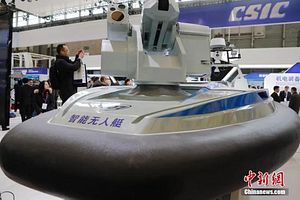Earlier this month, Chinese researchers first demonstrated what they claimed is the world’s fastest unmanned surface vehicle (USV). Dubbed Tianxing-1, the vessel was publicly displayed at the fifth China Marine Economy Expo in Zhanjiang and at the All China Maritime Conference and Exhibition (Marintec China) in Shanghai, according to Jane’s Defense Weekly.
According to Chinese reports, the vessel was “[j]ointly researched and developed by Harbin Engineering University and Shenzhen HiSiBi Boats Company.” Production of the first USV unit was completed earlier this year, in September.
The USV has a claimed top speed of more than 50 knots (92.6 kilometers per hour). It has a length of 12.2 meters and a 7.5 ton displacement. It is propelled by a hybrid electric-gasoline engine. The USV’s armament options have not been publicized, but in released images, the demonstration unit appears to have a range of swiveling sensors and may potentially be able to carry small weapons.
“The USV can be used in maritime law enforcement and as an addition to navy manpower. It also can be used in dangerous situations,” Huang Zhuo of HiSiBi Boats Company told China Plus.
“Previously, the world’s fastest USV was part of the British military, with a top speed of 50 knots. However, this Chinese-made one has overtaken it and become the fastest,” he added. “Some manned speedboats can reach up to 70 knots in speed but need to be controlled by experienced drivers as heavy storms and obstacles may increase the risk of danger. This is also a challenge the USV faces.”
Huang was likely referring to the Royal Navy’s Maritime Autonomy Surface Testbed (MAST) vessel, which was first revealed last year. The vessel is smaller than the Chinese USV and is equipped with radar, electro-optical, infrared, and digital sensors for intelligence, surveillance, and reconnaissance applications. The vessels may eventually also have an anti-submarine warfare role, though this remains in development.
A separate Royal Navy project, the Sensor Hosting Autonomous Remote Craft (SHARC), has shown an ability to detect and track manned and unmanned submarines. Anti-submarine warfare continues to be an active area of research and development for the Chinese Navy and coast guard as submarines proliferate among regional navies in Southeast Asia. USVs may provide a promising platform for undersea surveillance.

































